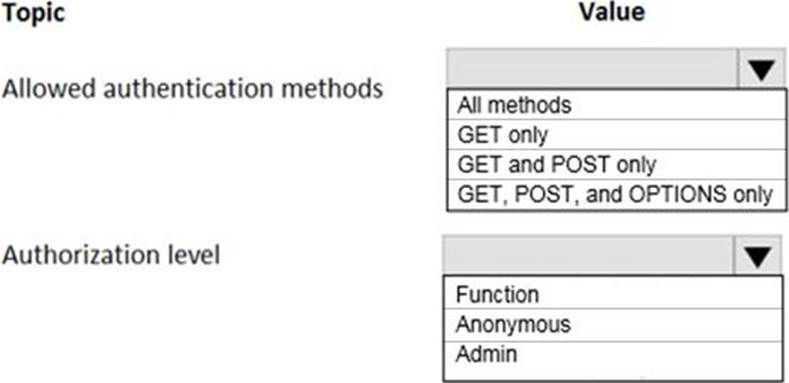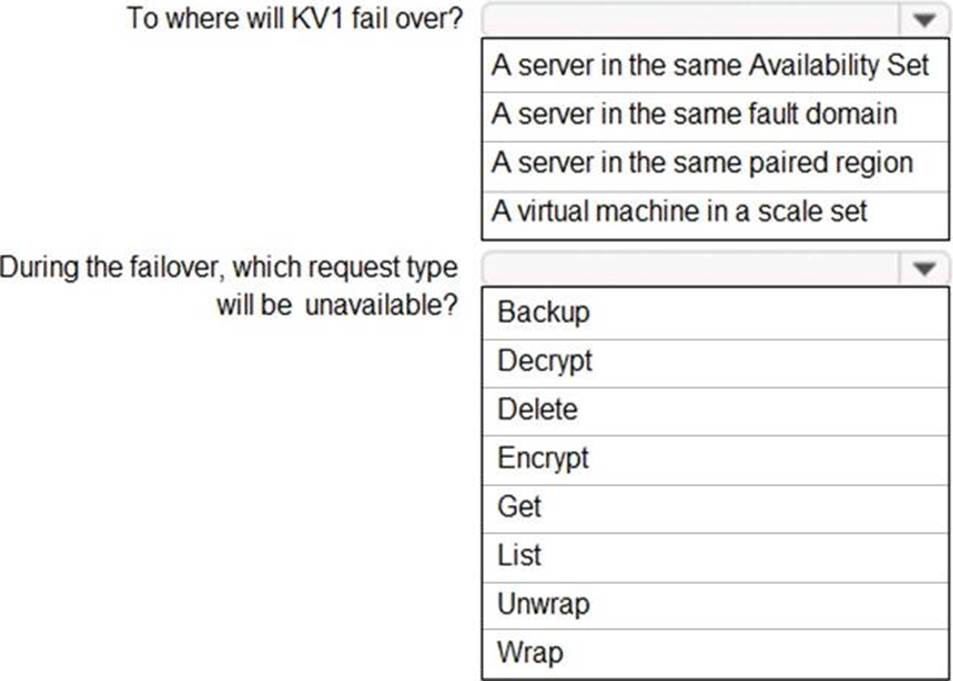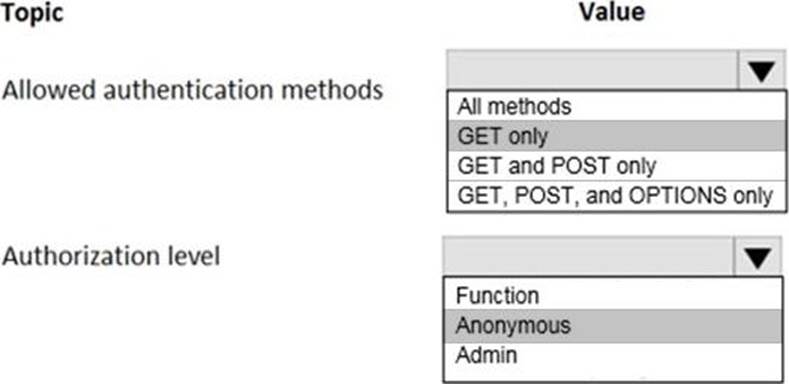Microsoft AZ-305 Real Exam Questions
The questions for AZ-305 were last updated at Nov 12,2025.
- Exam Code: AZ-305
- Exam Name: Designing Microsoft Azure Infrastructure Solutions
- Certification Provider: Microsoft
- Latest update: Nov 12,2025
HOTSPOT
A company plans to implement an HTTP-based API to support a web app. The web app allows customers to check the status of their orders.
The API must meet the following requirements:
✑ Implement Azure Functions
✑ Provide public read-only operations
✑ Do not allow write operations
You need to recommend configuration options.
What should you recommend? To answer, configure the appropriate options in the dialog box in the answer area. NOTE: Each correct selection is worth one point.

You need to implement the Azure RBAC role assignments for the Network Contributor role. The solution must meet the authentication and authorization requirements.
What is the minimum number of assignments that you must use?
- A . 1
- B . 2
- C . 5
- D . 10
- E . 15
Topic 4, HABInsurance
Case Study
Overview
An insurance company, HABInsurance, operates in three states and provides home, auto, and boat insurance. Besides the head office, HABInsurance has three regional offices.
Current environment
General
An insurance company, HABInsurance, operates in three states and provides home, auto, and boat insurance. Besides the head office, HABInsurance has three regional offices.
Technology assessment
The company has two Active Directory forests: main.habinsurance.com and region.habinsurance.com. HABInsurance’s primary internal system is Insurance Processing System (IPS). It is an ASP.Net/C# application running on IIS/Windows Servers hosted in a data center. IPS has three tiers: web, business logic API, and a datastore on a back end. The company uses Microsoft SQL Server and MongoDB for the backend. The system has two parts: Customer data and Insurance forms and documents. Customer data is stored in Microsoft SQL Server and Insurance forms and documents ― in MongoDB. The company also has 10 TB of Human Resources (HR) data stored on NAS at the head office location. Requirements
General
HABInsurance plans to migrate its workloads to Azure. They purchased an Azure subscription.
Changes
During a transition period, HABInsurance wants to create a hybrid identity model along with a Microsoft Office 365 deployment. The company intends to sync its AD forests to Azure AD and benefit from Azure AD administrative units functionality.
HABInsurance needs to migrate the current IPSCustomers SQL database to a new fully managed SQL database in Azure that would be budget-oriented, balanced with scalable compute and storage options. The management team expects the Azure database service to scale the database resources dynamically with minimal downtime. The technical team proposes implementing a DTU-based purchasing model for the new database.
HABInsurance wants to migrate Insurance forms and documents to Azure database service. HABInsurance plans to move IPS first two tiers to Azure without any modifications. The technology team discusses the possibility of running IPS tiers on a set of virtual machines instances. The number of instances should be adjusted automatically based on the CPU utilization. An SLA of 99.95% must be guaranteed for the compute infrastructure.
The company needs to move HR data to Azure File shares.
In their new Azure ecosystem, HABInsurance plans to use internal and third-party applications. The company considers adding user consent for data access to the registered applications
Later, the technology team contemplates adding a customer self-service portal to IPS and deploying a new IPS to multi-region ASK. But the management team is worried about performance and availability of the multi-region AKS deployments during regional outages.
A company has an on-premises file server cbflserver that runs Windows Server 2019. Windows Admin Center manages this server. The company owns an Azure subscription. You need to provide an Azure solution to prevent data loss if the file server fails.
Solution: You decide to create an Azure Recovery Services vault. You then decide to install the Azure Backup agent and then schedule the backup.
Would this meet the requirement?
- A . Yes
- B . No
You plan to move a web application named App1 from an on-premises data center to Azure.
App1 depends on a custom COM component that is installed on the host server.
You need to recommend a solution to host App1 in Azure.
The solution must meet the following requirements:
✑ App1 must be available to users if an Azure data center becomes unavailable.
✑ Costs must be minimized.
What should you include in the recommendation?
- A . In two Azure regions, deploy a load balancer and a virtual machine scale set.
- B . In two Azure regions, deploy a Traffic Manager profile and a web app.
- C . In two Azure regions, deploy a load balancer and a web app.
- D . Deploy a load balancer and a virtual machine scale set across two availability zones.
You are designing a large Azure environment that will contain many subscriptions.
You plan to use Azure Policy as part of a governance solution.
To which three scopes can you assign Azure Policy definitions? Each correct answer presents a complete solution. NOTE: Each correct selection is worth one point.
- A . management groups
- B . subscriptions
- C . Azure Active Directory (Azure AD) tenants
- D . resource groups
- E . Azure Active Directory (Azure AD) administrative units
- F . compute resources
HOTSPOT
You have an Azure web app named App1 and an Azure key vault named KV1.
App1 stores database connection strings in KV1.
App1 performs the following types of requests to KV1:
✑ Get
✑ List
✑ Wrap
✑ Delete
✑ Unwrap
✑ Backup
✑ Decrypt
✑ Encrypt
You are evaluating the continuity of service for App1.
You need to identify the following if the Azure region that hosts KV1 becomes unavailable:
✑ To where will KV1 fail over?
✑ During the failover, which request type will be unavailable?
What should you identify? To answer, select the appropriate options in the answer area. NOTE: Each correct selection is worth one point.

You have an on-premises network and an Azure subscription. The on-premises network has several branch offices.
A branch office in Toronto contains a virtual machine named VM1 that is configured as a file server.
Users access the shared files on VM1 from all the offices.
You need to recommend a solution to ensure that the users can access the shares files as quickly as possible if the Toronto branch office is inaccessible.
What should you include in the recommendation?
- A . a Recovery Services vault and Azure Backup
- B . an Azure file share and Azure File Sync
- C . Azure blob containers and Azure File Sync
- D . a Recovery Services vault and Windows Server Backup
What should you recommend to meet the monitoring requirements for App2?
- A . Microsoft Sentinel
- B . Azure Application Insights
- C . Container insights
- D . VM insights
Note: This question is part of a series of questions that present the same scenario. Each question in the series contains a unique solution that might meet the stated goals. Some question sets might have more than one correct solution, while others might not have a correct solution.
After you answer a question in this section, you will NOT be able to return to it. As a result, these questions will not appear in the review screen.
Your company deploys several virtual machines on-premises and to Azure. ExpressRoute is being deployed and configured for on-premises to Azure connectivity.
Several virtual machines exhibit network connectivity issues.
You need to analyze the network traffic to identify whether packets are being allowed or denied to the virtual machines.
Solution: Use Azure Traffic Analytics in Azure Network Watcher to analyze the network traffic.
Does this meet the goal?
- A . Yes
- B . No
Note: This question is part of a series of questions that present the same scenario. Each question in the series contains a unique solution that might meet the stated goals. Some question sets might have more than one correct solution, while others might not have a correct solution.
After you answer a question in this section, you will NOT be able to return to it. As a result, these questions will not appear in the review screen.
Your company has deployed several virtual machines (VMs) on-premises and to Azure. Azure ExpressRoute has been deployed and configured for on-premises to Azure connectivity.
Several VMs are exhibiting network connectivity issues.
You need to analyze the network traffic to determine whether packets are being allowed or denied to the VMs.
Solution: Install and configure the Microsoft Monitoring Agent and the Dependency Agent on all VMs. Use the Wire Data solution in Azure Monitor to analyze the network traffic.
Does the solution meet the goal?
- A . Yes
- B . No


